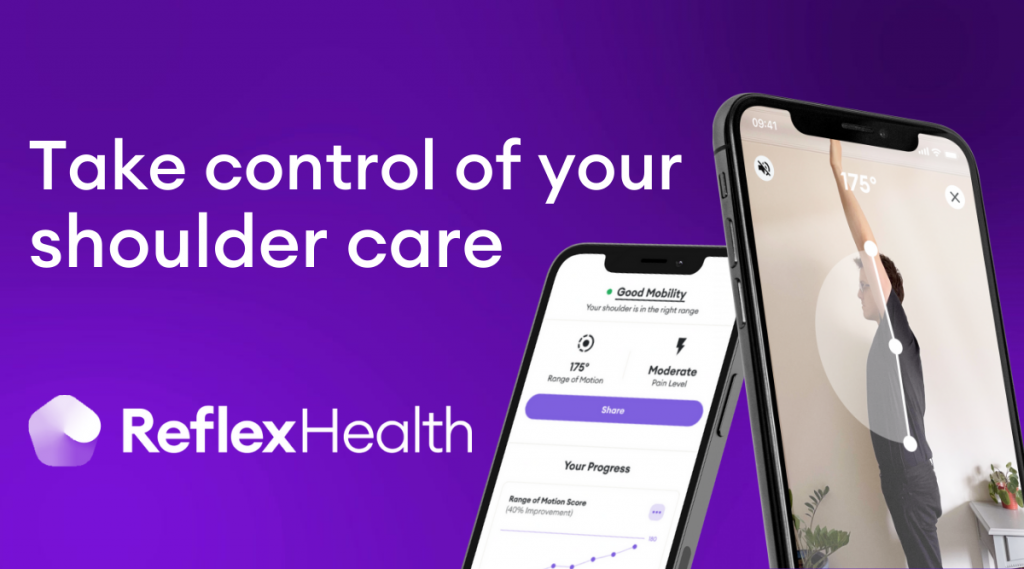Not my favourite day.
“My shoulder has become increasingly difficult to move and mysteriously stiff.”
After a comprehensive online assessment, I’ve just had to explain to an unsuspecting patient that they are most likely at the beginning of a long journey of pain, stiffness and poor mobility. Yes, ladies and gents, we are talking about a Frozen ShoulderA condition where shoulder movement becomes very limited and painful. The cause is often unknown, bu More diagnosis.
My role
As Physiotherapists, we have a duty to treat, manage, set expectations but also bring hope and various treatment options. The reality is that the journey is long, arduous and that it will affect daily life, lasting an average 2.5 years – with the majority of people recovering well with the right therapy and intervention. I also seek to bring the big picture, inspire and offer up different treatment options to suit different individuals. Throughout the journey, I believe it is vital to integrate foundational practices in. Janice does so well to describe her in her Frozen Shoulder journey here. Check it out!
What is ‘Frozen Shoulder?’
The shoulder is made up of a ball (top of your arm bone, the humerus) and socket (shallow hollow from your shoulder blade, the scapula) joint.
The entire joint is enclosed within a strong, fibrous capsule that ensures stability and strength with some lovely synovial fluid lubricating the joint. Frozen shoulder occurs when this capsule becomes thickened, contracted and tight with minimal synovial fluid.
Frozen Shoulder is also referred to as Adhesive Capsulitis, it is initially identified by dull pain (90%+ of people report this as their first symptom [1]), aching and a progressively restricted active and passive glenohumeral jointThe glenohumeral joint is a ball-and-socket synovial joint and is the most mobile joint in the human More range of motion such as Forward FlexionIs an upgoing movement from the front side or the sagittal plane facilitated by the pectorals, anter More, ExtensionIs a backward going movement facilitated by the Latissimus dorsi a.k.a the largest back muscle in te More, and AbductionIs a sideways upgoing movement in the frontal plane brought about by the supraspinatus and the mid More.
The pathophysiology of Frozen Shoulder
Post-mortem analysis of a person with Frozen Shoulder (not cause of death!), combined with results from open arthroscopic surgery both showed synovial hyperplasia (thickened joint structures) with increased vascularization (blood flow) during the phase 1 – freezing [2]. This phase ends with a developing fibrosis (thickening) situated mainly in the rotator cuffThe rotator cuff is a group of muscles and tendons that attach the shoulder blade to the upper arm b More connection (which is made up of the tendons of the subscapularisSubscapularis is a muscle and tendon that connects the scapula to the front of the head of the humer More, biceps brachii and supraspinatusThe supraspinatus is a muscle and tendon in the shoulder that connects the Shoulder blade (scapula) More muscles, and the coracohumeral and superior glenohumeral ligaments), together with the base of the coracoid process [3], and in the subscapular recess [4].
The thickening of the coracohumeral ligament is suggested as one of the specific origins of Frozen Shoulder and the main reason for limited external rotationThe range of shoulder external rotation is one of the most important metrics in the field of general More, although due to its close relationship with the subscapularis and supraspinatus tendons it also helpfully contributes to restriction of internal rotation [5]. In more advanced stages of Frozen Shoulder, the thickening and contraction of the glenohumeral capsule culminates in limiting the range of movement in all directions [2].
In simple language, studies have shown the thickening of the shoulder structures in key places, and reduction in lubricating fluid in those with Frozen Shoulder.
What causes Frozen Shoulder?
Today’s lifestyle has dramatically reduced the use of the upper limbs, in contrast to the last 1000 years, where manual labour and household activities were completed daily – whereas in 2022, a lot of manual activity is now completed by machines. This decrease in use has likely led to atrophy of parts of the complex ligament capsule of the shoulder [6]. Which could be why we are seeing Frozen Shoulder being more prevalent in the world today.
Frozen Shoulder Symptoms
Symptoms aren’t completely linear, and 2 and 4 stage models have been proposed. I propose that this phase is most helpful [7] [8], and here are some common traits of each phase.
Frozen Shoulder Symptoms – Phase 1: The Freezing Stage
- The shoulder will slowly develop pain that worsens when it is moved [1].
- This is suggested to be from the gradual lessening of lubrication, and shortening muscle-tendon junctions.
- It will also become stiffer as time goes on. This is where the term ‘freezing’ comes from.
- This stiffness is due to the reduction of synovial fluid (the lubricating oil of the joint) and the thickening of structures within the joint – this is also why overhead movements hurt so much.
- External rotation is often the first to be limited and last to return due to the early and long-lasting thickening found by studies of the coracohumeral ligament, the structure that ordinarily facilitates this movement.
- This phase may last from 2-9 months.
Frozen Shoulder Symptoms – Phase 2: The Frozen Stage
- This follows the freezing phase, and although pain may get less, moving the shoulder gets harder, which affects day-to-day activities, often reducing people to leaning back to achieve ‘normal activities’. It is often this phase which people report to be the most challenging.
- This phase may last up to 12 months.
Frozen Shoulder Symptoms – Phase 3: Thawing
- This is our resolution or ‘thawing’ phase. The stiffness gradually eases and most people make a full recovery with physio-led strength and mobility programmes or surgical interventions.
- Despite common belief, it is unlikely for there to be maximal recovery gained spontaneously (without intervention).
- This phase can last up to 2 years [9]
- It has been reported that only 15% of people experience Frozen Shoulder in the opposite shoulder within 5 years [10]
In conclusion
Frozen Shoulder is a mysteriously painful and activity-stopping condition that requires patience over the journey, and often takes its toll on many different aspects of life, as Janice describes for herself in her previous blog post titled “Freezing, Frozen and Thawing, my 3 phases of Frozen Shoulder”.
The duration of Frozen Shoulder is from 1 to 3.5 years with a mean of 30 months.
Each phase will end, and you shall move closer to getting back to what you love!
There are various ways in which we can reduce the likelihood of getting Frozen Shoulder, diagnose Frozen Shoulder, manage Frozen Shoulder and how best to gain fast recovery. All of that shall have to wait for our next instalment!
 References:
References:
[1] Boyle-Walker KL, Gabard DL, Bietsch E, et al. A profile of patients with adhesive capsulitis. J Hand Ther 1997; 10: 222–228. [PubMed] [Google Scholar] [Ref list]
[2] Cho CH, Song KS, Kim BS, Kim DH, Lho YM. Biological aspect of pathophysiology for frozen shoulder. Biomed Res Int. (2018) 2018:7274517. doi: 10.1155/2018/7274517 PubMed Abstract | CrossRef Full Text | Google Scholar
[3] Lluch-Girbés E, Dueñas L, Mena-del Horno S, Luque-Suarez A, Navarro-Ledesma S, Louw A. A central nervous system-focused treatment approach for people with frozen shoulder: protocol for a randomized clinical trial. Trials. (2019) 20:498. doi: 10.1186/s13063-019-3585-z PubMed Abstract | CrossRef Full Text | Google Scholar
[4] Uitvlugt G, Detrisac DA, Johnson LL, Austin MD, Johnson C. Arthroscopic observations before and after manipulation of frozen shoulder. Arthroscopy. (1993) 9:181–5. doi: 10.1016/S0749-8063(05)80371-8 PubMed Abstract | CrossRef Full Text | Google Scholar
[5] Hagiwara Y, Ando A, Kanazawa K, Koide M, Sekiguchi T, Hamada J, et al. Arthroscopic coracohumeral ligament release for patients with frozen shoulder. Arthrosc Tech. (2017) 7:e1–5. doi: 10.1016/j.eats.2017.07.027 PubMed Abstract | CrossRef Full Text | Google Scholar
[6] Pietrzak M. Adhesive capsulitis: an age related symptom of metabolic syndrome and chronic low-grade inflammation? Med Hypotheses. (2016) 88:12–7. doi: 10.1016/j.mehy.2016.01.002
PubMed Abstract | CrossRef Full Text | Google Scholar
[7] Hannafin JA, Chiaia TA. Adhesive capsulitis: a treatment approach. Clin Orthop Relat Res. (2000) 372:95–109. doi: 10.1097/00003086-200003000-00012 CrossRef Full Text | Google Scholar
[8] Favejee MM, Huisstede B, Koes BW. Frozen shoulder: the effectiveness of conservative and surgical interventions—systematic review. Br J Sports Med. (2011) 45:49–56. doi: 10.1136/bjsm.2010.071431 CrossRef Full Text | Google Scholar
[9] Wong CK, Levine WN, Deo K, Kesting RS, Mercer EA, Schram GA, et al. Natural history of frozen shoulder: fact or fiction? A systematic review. Physiotherapy. (2017) 103:40–7. doi: 10.1016/j.physio.2016.05.009 PubMed Abstract | CrossRef Full Text | Google Scholar[10] Mezian K, Coffey R, Chang KV. Frozen Shoulder. [Updated 2021 Sep 1]. In: StatPearls [Internet]. Treasure Island (FL): StatPearls Publishing; 2022 Jan-. Available from: https://www.ncbi.nlm.nih.gov/books/NBK482162/

